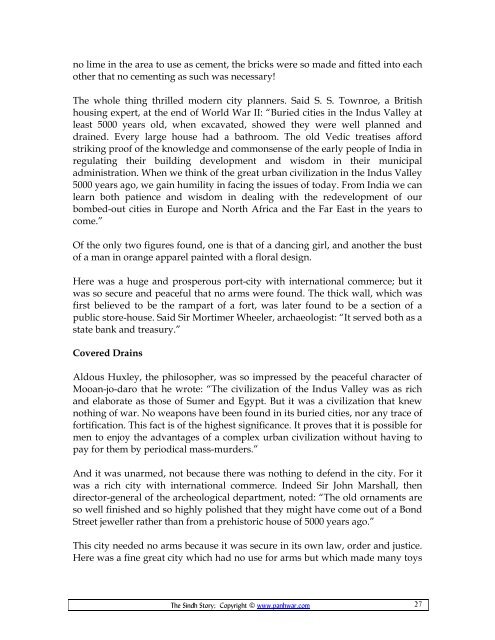You also want an ePaper? Increase the reach of your titles
YUMPU automatically turns print PDFs into web optimized ePapers that Google loves.
no lime in the area to use as cement, the bricks were so made and fitted into each<br />
other that no cementing as such was necessary!<br />
The whole thing thrilled modern city planners. Said S. S. Townroe, a British<br />
housing expert, at the end of World War II: “Buried cities in the Indus Valley at<br />
least 5000 years old, when excavated, showed they were well planned and<br />
drained. Every large house had a bathroom. The old Vedic treatises afford<br />
striking proof of the knowledge and commonsense of the early people of India in<br />
regulating their building development and wisdom in their municipal<br />
administration. When we think of the great urban civilization in the Indus Valley<br />
5000 years ago, we gain humility in facing the issues of today. From India we can<br />
learn both patience and wisdom in dealing with the redevelopment of our<br />
bombed-out cities in Europe and North Africa and the Far East in the years to<br />
come.”<br />
Of the only two figures found, one is that of a dancing girl, and another the bust<br />
of a man in orange apparel painted with a floral design.<br />
Here was a huge and prosperous port-city with international commerce; but it<br />
was so secure and peaceful that no arms were found. The thick wall, which was<br />
first believed to be the rampart of a fort, was later found to be a section of a<br />
public store-house. Said Sir Mortimer Wheeler, archaeologist: “It served both as a<br />
state bank and treasury.”<br />
Covered Drains<br />
Aldous Huxley, the philosopher, was so impressed by the peaceful character of<br />
Mooan-jo-daro that he wrote: “The civilization of the Indus Valley was as rich<br />
and elaborate as those of Sumer and Egypt. But it was a civilization that knew<br />
nothing of war. No weapons have been found in its buried cities, nor any trace of<br />
fortification. This fact is of the highest significance. It proves that it is possible for<br />
men to enjoy the advantages of a complex urban civilization without having to<br />
pay for them by periodical mass-murders.”<br />
And it was unarmed, not because there was nothing to defend in the city. For it<br />
was a rich city with international commerce. Indeed Sir John Marshall, then<br />
director-general of the archeological department, noted: “The old ornaments are<br />
so well finished and so highly polished that they might have come out of a Bond<br />
Street jeweller rather than from a prehistoric house of 5000 years ago.”<br />
This city needed no arms because it was secure in its own law, order and justice.<br />
Here was a fine great city which had no use for arms but which made many toys<br />
The Sindh Story; Copyright © www.panhwar.com<br />
27


